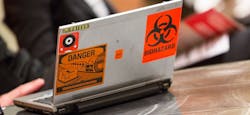10 things about Ebola from Eagleson Institute's infectious disease colloquium
- The 2014 Ebola outbreak was first identified by a clinical doctor who recognized one unusual symptom in a cluster of his patients: hiccups!
- What happens in West Africa does not stay in West Africa.
- The good news is: Ebola is not very contagious—it only spreads person-to-person through bodily fluids and not easily.
- The bad news is: Ebola is dangerously infectious—it only takes a single particle of virus to infect someone. In comparison, it takes 100 particles of HIV and 1000 particles of the flu virus.
- The University of Nebraska Medical Center put out close to a hundred informative videos on iTunes University (including some in Spanish) that have garnered over 55 million views.
- It’s all about people: Not surprisingly, we remember the picture of the doctor in Sierra Leone—not the one of the filtered air duct.
- A treadmill in every room: Patients start to feel stir crazy as they get better, days or weeks before they can be safely discharged.
- Use of hand-sanitizer is up and hospital-acquired infections down in hospitals that handled confirmed and suspected Ebola patients.
- Google developed an Ebola-proof tablet.
- Wash your hands!
About the Author: Ellen Randall is a writer with HDR’s Communications Group, and a 13-year veteran of HDR. In her current role, she writes extensively about design and Science + Technology—where her past life as an architect and her natural curiosity about scientific processes serve her well. She is married to an architect (typical architect move!) and they have three grown girls. In her free time, Randall is a long-distance swimmer and a songwriter.
About the Author
HDR
HDR's Insights blog is written by our employees. While we are most well-known for delivering architecture and engineering services—for adding beauty and structure to communities through high performance buildings and smart infrastructure, we provide much more than that. We create an unshakable foundation for progress because our multidisciplinary teams also include scientists, economists, builders, analysts and artists. Our thought leader bloggers represent offices from around the world and write about ideas, experiences and insights into our practice and the greater design community. Follow us on Facebook, Instagram, LinkedIn, Twitter, and YouTube.
